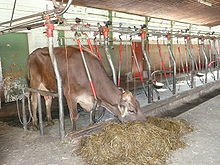Pipe milking system
Tube milking systems were an advancement in dairy farming in the 1960s and 1970s before being replaced by milking parlors .
distribution
Today they are only used in smaller stocks. In Germany, pipe milking systems have not been built for years, nor have they been subsidized in the agricultural investment promotion programs.
Procedural advantages
The advantages compared to the bucket milking system were better work productivity and better hygiene of the milk, as it no longer came into contact with the stable air.
technology
Pipe milking systems are used in tie-up stalls . These are equipped with fixed milk and vacuum lines. The milking implement is carried from cow to cow and connected to the lines there. The milk is now sucked into the milk line by the milking cluster and from there into the milk separator . This is where the milk is collected. The last route leads the milk from there into the milk container, where it is cooled to a maximum of 8 ° C (6 ° C for two-day collection). A pulsator is connected to the vacuum line . It controls the suction and discharge phases. The vacuum is generated by means of a vacuum pump that is electrically driven. Control valves regulate the vacuum and keep it constant.
A cleaning system must also be connected to a pipe milking system. Here, approx. 50 ° C hot water with disinfectants is rinsed into the milk lines and the milking implements, followed by rinsing with drinking water.
